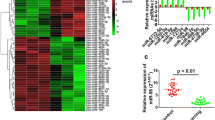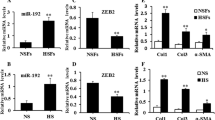Abstract
Hypertrophic scar (HS) is a fibrotic disease caused by skin injury. Competing endogenous RNA (ceRNA) has been demonstrated to implicate in the regulation of cell malignant phenotypes. This research aims to reveal the effect of catenin beta 1 (CTNNB1) on the functions of hypertrophic scar fibroblasts (HSFBs) and its role in a ceRNA network. RNA expression level was assessed by quantitative reverse transcription polymerase chain reaction (RT-qPCR). The proliferation and apoptosis of HSFB was detected via Cell Counting Kit-8 (CCK-8) assay and flow cytometry analysis. Mechanism experiments included RNA pull down assay, luciferase reporter assay and RNA-binding protein immunoprecipitation (RIP) assay were applied to analyze the upstream molecular mechanism of CTNNB1. CTNNB1 was highly expressed in HSFB. CTNNB1 depletion repressed malignant growth of HSFB. Mechanically, CTNNB1 was targeted by microRNA-320b (miR-320b) in HSFB. Small nucleolar RNA host gene 1 (SNHG1) aced as a ceRNA to upregulate CTNNB1 expression via sponging miR-320b in HSFB. CTNNB1 overexpression could reverse the impact of SNHG1 depletion on the proliferation and apoptosis of HSFB. SNHG1 acts as a ceRNA in modulating HSFB proliferation and apoptosis through miR-320b/CTNNB1 axis.
Graphical abstract

SNHG1 act as a ceRNA to promote HSFB growth by sponging miR-320b to upregulate CTNNB1.




Similar content being viewed by others
Data availability statement
Not applicable.
Abbreviations
- ANOVA:
-
Analysis of variance
- CTNNB1:
-
Catenin beta 1
- CCK-8:
-
Cell counting kit-8
- ceRNA:
-
Competing endogenous RNA
- cDNA:
-
Complementary DNA
- HS:
-
Hypertrophic scar
- HSFBs:
-
Hypertrophic scar fibroblasts
- lncRNAs:
-
Long-noncoding RNAs
- mRNAs:
-
Messenger RNAs
- miRNAs:
-
MicroRNAs
- NC:
-
Negative control
- RT-qPCR:
-
Quantitative reverse transcription polymerase chain reaction
- RIP:
-
RNA-binding protein immunoprecipitation
- shRNAs:
-
Short hairpin RNAs
- SNHG1:
-
Small nucleolar RNA host gene 1
- SUZ12:
-
SUZ12 polycomb repressive complex 2 subunit
References
Lingzhi Z, Meirong L, Xiaobing F (2020) Biological approaches for hypertrophic scars. Int Wound J 17(2):405–418. https://doi.org/10.1111/iwj.13286
Wang ZC, Zhao WY, Cao Y, Liu YQ, Sun Q, Shi P, Cai JQ, Shen XZ, Tan WQ (2020) The roles of inflammation in keloid and hypertrophic scars. Front Immunol 11:603187. https://doi.org/10.3389/fimmu.2020.603187
Li K, Nicoli F, Cui C, Xi WJ, Al-Mousawi A, Zhang Z, Balzani A, Neill L, Sorge R, Tong Y, Zhang Y (2020) Treatment of hypertrophic scars and keloids using an intralesional 1470 nm bare-fibre diode laser: a novel efficient minimally-invasive technique. Sci Rep 10(1):21694. https://doi.org/10.1038/s41598-020-78738-9
Xie F, Teng L, Xu J, Lu J, Zhang C, Yang L, Ma X, Zhao M (2020) Interleukin-10 modified bone marrow mesenchymal stem cells prevent hypertrophic scar formation by inhibiting inflammation. Pharmazie 75(11):571–575. https://doi.org/10.1591/ph.2020.0572
Gholipourmalekabadi M, Khosravimelal S, Nokhbedehghan Z, Sameni M, Jajarmi V, Urbanska AM, Mirzaei H, Salimi M, Chauhan NPS, Mobaraki M, Reis RL, Samadikuchaksaraei A, Kundu SC (2019) Modulation of hypertrophic scar formation using amniotic membrane/electrospun silk fibroin bilayer membrane in a rabbit ear model. ACS Biomater Sci Eng 5(3):1487–1496. https://doi.org/10.1021/acsbiomaterials.8b01521
Lee HJ, Jang YJ (2018) Recent understandings of biology prophylaxis and treatment strategies for hypertrophic scars and keloids. Int J Mol Sci. https://doi.org/10.3390/ijms19030711
Coentro JQ, Pugliese E, Hanley G, Raghunath M, Zeugolis DI (2019) Current and upcoming therapies to modulate skin scarring and fibrosis. Adv Drug Deliv Rev 146:37–59. https://doi.org/10.1016/j.addr.2018.08.009
Wei Z, Tian Z, Zhang L (2021) CircPPP1R12A promotes the progression of colon cancer through regulating CTNNB1 via sponging miR-375. Anticancer Drugs 32(6):635–646. https://doi.org/10.1097/cad.0000000000001037
Chai W, Liu R, Li F, Zhang Z, Lei B (2021) Long noncoding RNA TSLNC8 enhances pancreatic cancer aggressiveness by regulating CTNNB1 expression via association with HuR. Hum Cell 34(1):165–176. https://doi.org/10.1007/s13577-020-00429-4
Ye G, Yang Q, Lei X, Zhu X, Li F, He J, Chen H, Ling R, Zhang H, Lin T, Liang Z, Liang Y, Huang H, Guo W, Deng H, Liu H, Hu Y, Yu J, Li G (2020) Nuclear MYH9-induced CTNNB1 transcription, targeted by staurosporin, promotes gastric cancer cell anoikis resistance and metastasis. Theranostics 10(17):7545–7560. https://doi.org/10.7150/thno.46001
Zhang X, Yao J, Shi H, Gao B, Zhang L (2019) LncRNA TINCR/microRNA-107/CD36 regulates cell proliferation and apoptosis in colorectal cancer via PPAR signaling pathway based on bioinformatics analysis. Biol Chem 400(5):663–675. https://doi.org/10.1515/hsz-2018-0236
Wei J, Wang Z, Zhong C, Ding H, Wang X, Lu S (2021) LncRNA MIR503HG promotes hypertrophic scar progression via miR-143–3p-mediated Smad3 expression. Wound Repair Regen 29(5):792–800. https://doi.org/10.1111/wrr.12913
Wei Y, Wang T, Zhang N, Ma Y, Shi S, Zhang R, Zheng X, Zhao L (2021) LncRNA TRHDE-AS1 inhibit the scar fibroblasts proliferation via miR-181a-5p/PTEN axis. J Mol Histol 52(2):419–426. https://doi.org/10.1007/s10735-021-09968-y
Nong Q, Li S, Wu Y, Liu D (2018) LncRNA COL1A2-AS1 inhibits the scar fibroblasts proliferation via regulating miR-21/Smad7 pathway. Biochem Biophys Res Commun 495(1):319–324. https://doi.org/10.1016/j.bbrc.2017.11.027
Zong S, Dai W, Guo X, Wang K (2021) LncRNA-SNHG1 promotes macrophage M2-like polarization and contributes to breast cancer growth and metastasis. Aging 13(19):23169–23181. https://doi.org/10.18632/aging.203609
Xu M, Chen X, Lin K, Zeng K, Liu X, Pan B, Xu X, Xu T, Hu X, Sun L, He B, Pan Y, Sun H, Wang S (2018) The long noncoding RNA SNHG1 regulates colorectal cancer cell growth through interactions with EZH2 and miR-154-5p. Mol Cancer 17(1):141. https://doi.org/10.1186/s12943-018-0894-x
Wang H, Wang X, Zhang Y, Zhao J (2021) LncRNA SNHG1 promotes neuronal injury in Parkinson’s disease cell model by miR-181a-5p/CXCL12 axis. J Mol Histol 52(2):153–163. https://doi.org/10.1007/s10735-020-09931-3
Qi X, Zhang DH, Wu N, Xiao JH, Wang X, Ma W (2015) ceRNA in cancer: possible functions and clinical implications. J Med Genet 52(10):710–718. https://doi.org/10.1136/jmedgenet-2015-103334
Wu Q, Chen J, Tan Z, Wang D, Zhou J, Li D, Cen Y (2021) Long non-coding RNA (lncRNA) nuclear enriched abundant transcript 1 (NEAT1) regulates fibroblast growth factor receptor substrate 2 (FRS2) by targeting microRNA (miR)-29-3p in hypertrophic scar fibroblasts. Bioengineered 12(1):5210–5219. https://doi.org/10.1080/21655979.2021.1959221
Xu H, Guo X, Tian Y, Wang J (2022) Knockdown of lncRNA-NEAT1 expression inhibits hypoxia-induced scar fibroblast proliferation through regulation of the miR-488-3p/COL3A1 axis. Exp Ther Med 24(1):442. https://doi.org/10.3892/etm.2022.11369
Yang Y, Xiao C, Liu K, Song L, Zhang Y, Dong B (2021) Silencing of long noncoding INHBA antisense RNA1 suppresses proliferation, migration, and extracellular matrix deposition in human hypertrophic scar fibroblasts via regulating microRNA-141-3p/myeloid cell leukemia 1 axis. Bioengineered 12(1):1663–1675. https://doi.org/10.1080/21655979.2021.1919013
Meng L, Li Z, Chen Y, Liu D, Liu Z (2020) LINC00689 promotes prostate cancer progression via regulating miR-496/CTNNB1 to activate Wnt pathway. Cancer Cell Int 20:215. https://doi.org/10.1186/s12935-020-01280-1
Ault P, Plaza A, Paratz J (2018) Scar massage for hypertrophic burns scarring—a systematic review. Burns 44(1):24–38. https://doi.org/10.1016/j.burns.2017.05.006
Tu L, Lin Z, Huang Q, Liu D (2021) USP15 enhances the proliferation, migration, and collagen deposition of hypertrophic scar-derived fibroblasts by deubiquitinating TGF-βR1 in vitro. Plast Reconstr Surg 148(5):1040–1051. https://doi.org/10.1097/prs.0000000000008488
Ma X, Liu L (2021) Knockdown of FAM225B inhibits the progression of the hypertrophic scar following glaucoma surgery by inhibiting autophagy. Mol Med Rep. https://doi.org/10.3892/mmr.2021.11843
Liao Y, Feng J, Sun W, Wu C, Li J, Jing T, Liang Y, Qian Y, Liu W, Wang H (2021) CIRP promotes the progression of non-small cell lung cancer through activation of Wnt/β-catenin signaling via CTNNB1. J Exp Clin Cancer Res CR 40(1):275. https://doi.org/10.1186/s13046-021-02080-9
Chen M, Li L, Zheng PS (2019) SALL4 promotes the tumorigenicity of cervical cancer cells through activation of the Wnt/β-catenin pathway via CTNNB1. Cancer Sci 110(9):2794–2805. https://doi.org/10.1111/cas.14140
Ishiguro H, Wakasugi T, Terashita Y, Sakamoto N, Tanaka T, Mizoguchi K, Sagawa H, Okubo T, Takeyama H (2016) Decreased expression of CDH1 or CTNNB1 affects poor prognosis of patients with esophageal cancer. World J Surg Oncol 14(1):240. https://doi.org/10.1186/s12957-016-0956-8
Xu D, Yang F, Fan Y, Jing W, Wen J, Miao W, Ding X, Yang H (2021) LncRNA DLEU1 contributes to the growth and invasion of colorectal cancer via targeting miR-320b/PRPS1. Front Oncol 11:640276. https://doi.org/10.3389/fonc.2021.640276
Lv GY, Miao J, Zhang XL (2018) Long noncoding RNA XIST promotes osteosarcoma progression by targeting ras-related protein RAP2B via miR-320b. Oncol Res 26(6):837–846. https://doi.org/10.3727/096504017x14920318811721
Zhuang Q, Jin Z, Zheng X, Jin T, Xiang L (2021) Long non-coding RNA LINC00460 serves as a potential biomarker and oncogene via regulation of the miR-320b/PBX3 axis in acute myeloid leukemia. Mol Med Rep. https://doi.org/10.3892/mmr.2021.12074
Zhang S, Zhang X, Sun Q, Zhuang C, Li G, Sun L, Wang H (2019) LncRNA NR2F2-AS1 promotes tumourigenesis through modulating BMI1 expression by targeting miR-320b in non-small cell lung cancer. J Cell Mol Med 23(3):2001–2011. https://doi.org/10.1111/jcmm.14102
Wang Y, Niu H, Liu Y, Yang H, Zhang M, Wang L (2020) Promoting effect of long non-coding RNA SNHG1 on osteogenic differentiation of fibroblastic cells from the posterior longitudinal ligament by the microRNA-320b/IFNGR1 network. Cell cycle (Georgetown, Tex) 19(21):2836–2850. https://doi.org/10.1080/15384101.2020.1827188
Liu Y, Yang Y, Li L, Liu Y, Geng P, Li G, Song H (2018) LncRNA SNHG1 enhances cell proliferation, migration, and invasion in cervical cancer. Biochem Cell Biol 96(1):38–43. https://doi.org/10.1139/bcb-2017-0188
Meng XF, Liu AD, Li SL (2020) SNHG1 promotes proliferation, invasion and EMT of prostate cancer cells through miR-195-5p. Eur Rev Med Pharmacol Sci 24(19):9880–9888. https://doi.org/10.26355/eurrev_202010_23198
Du Q, Chen J (2020) SNHG1 promotes proliferation, migration and invasion of bladder cancer cells via the PI3K/AKT signaling pathway. Exp Ther Med 20(5):110. https://doi.org/10.3892/etm.2020.9238
Kong X, Liu Z (2022) Repression of Mafb promotes foreskin fibroblast proliferation through upregulation of CDK2, cyclin E and PCNA. Andrologia 54(6):e14411. https://doi.org/10.1111/and.14411
Zhang L, Insel PA (2001) Bcl-2 protects lymphoma cells from apoptosis but not growth arrest promoted by cAMP and dexamethasone. Am J Physiol Cell Physiol 281(5):C1642-1647. https://doi.org/10.1152/ajpcell.2001.281.5.C1642
Acknowledgements
We appreciate all supports.
Funding
This study was supported by Chengdu Medical Research Project under grant (No. 2022199).
Author information
Authors and Affiliations
Contributions
QL conceived and designed the study and drafted the article. BZ, JL and QW performed the experiments. MH, LX and LZ prepared the digital images.
Corresponding author
Ethics declarations
Competing interests
The authors declare no competing interests.
Conflict of interests
The authors have declared that no conflict of interests.
Statement of ethics
Not applicable.
Additional information
Publisher's Note
Springer Nature remains neutral with regard to jurisdictional claims in published maps and institutional affiliations.
Rights and permissions
Springer Nature or its licensor (e.g. a society or other partner) holds exclusive rights to this article under a publishing agreement with the author(s) or other rightsholder(s); author self-archiving of the accepted manuscript version of this article is solely governed by the terms of such publishing agreement and applicable law.
About this article
Cite this article
Li, Q., Zhang, B., Lu, J. et al. SNHG1 functions as a ceRNA in hypertrophic scar fibroblast proliferation and apoptosis through miR-320b/CTNNB1 axis. Arch Dermatol Res 315, 1593–1601 (2023). https://doi.org/10.1007/s00403-022-02516-y
Received:
Revised:
Accepted:
Published:
Issue Date:
DOI: https://doi.org/10.1007/s00403-022-02516-y




